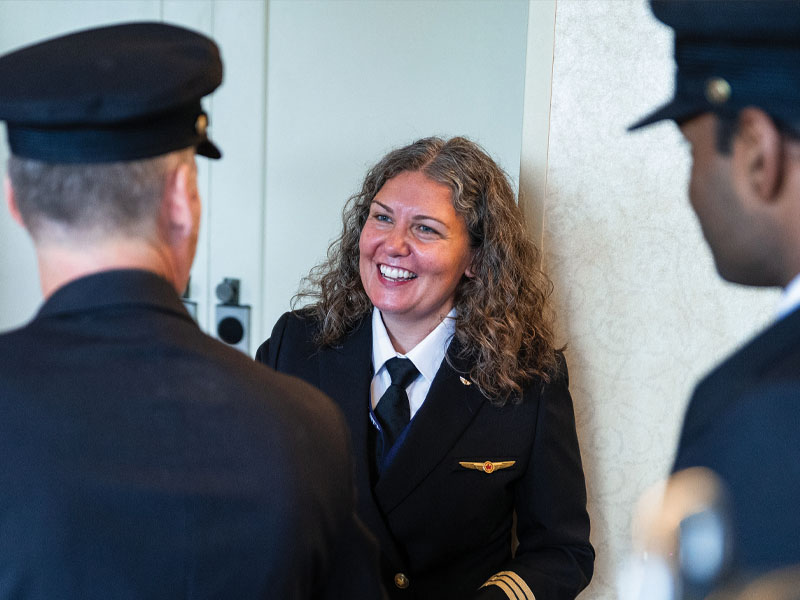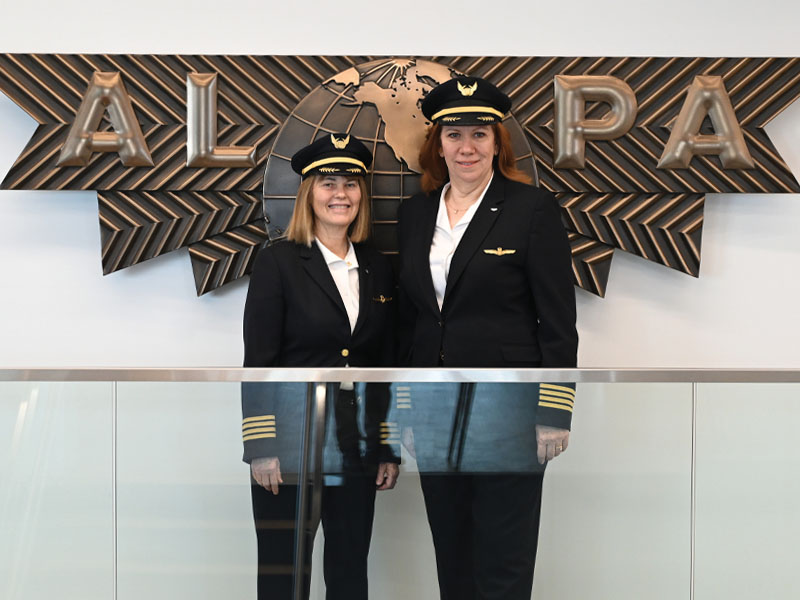ALPA’s Leading Women
By Julie Mayes, ALPA Senior Communications Specialist

F/O Charlene Hudy, the Air Canada pilots’ Master Executive Council (MEC) chair, talks with fellow pilots.
As the world’s largest pilots union, ALPA has a long history of advocating for pilots’ rights, safety and security, and working conditions. And beyond this legacy lies a growing community of women breaking barriers and taking flight as leaders within the Association’s ranks. Today, nearly 7 percent of ALPA’s 77,000 members are women, and their impact is undeniable.
While the number of women in ALPA has grown significantly—from 2 percent in 1985 when Capt. Mary Mitton (Comair) became the first elected female master executive council (MEC) chair—the airline industry still falls behind. Globally, only 5.2 percent of airline pilots are women.
“The percentage of female pilots in the industry has remained stubbornly low due in large part to the challenge of balancing work life and family life,” says Capt. Anne Worster (United), who was elected to lead ALPA’s largest pilot group in January. “As a pilot-mom and the wife of another ALPA pilot, I know how hard it is to balance the demands of flying professionally and the immense amount of time we spend away from our families.”
She contends that contractual improvements addressing quality of life could attract more women to the field. Even with such improvements, she acknowledges that inherent challenges remain within the industry itself.
“At United, far too many of our female pilots were furloughed—some twice—then found themselves unwilling or unable to manage the burden of being perpetually junior and frequently unemployed while balancing their family’s needs,” Worster notes. “Unfortunately, a large number of these women left flying altogether.”

Capt. Wendy Morse, ALPA’s first vice president and former United Master Executive Council (MEC) chair, left, and Capt. Anne Worster, the current United MEC chair, at ALPA’s McLean, Va., offices.
In 2016, F/O Karen Lacy (Delta) became the first female executive vice president elected by ALPA’s Board of Directors. Employed by ExpressJet at the time, she later moved on to Delta before receiving a furlough notice alongside 11,000 other U.S. ALPA pilots in 2020 during the pandemic. This experience was the most stressful of her life.
“My husband was an ALPA rep, which required a lot of time, especially during COVID, and I was trying to juggle full-time care for a young child while working on my real estate license to provide income if I was furloughed,” says Lacy.” It was a lot. Ultimately, I wasn’t furloughed and was able to continue flying.”
Today, female pilots who’ve weathered the industry’s challenges, joined by a rising generation of newcomers, are expanding access and opportunities for female aviators through their ALPA involvement.
“Over my five years at Piedmont, I’ve seen a significant increase in female pilots,” remarks Capt. Kimberley Gott (Piedmont), her pilot group’s MEC chair. “When I started, there were only about 10 of us, and all-female crews were almost unheard of. However, last year I flew with several, and new-hire classes are showing a clear upward trend in female recruits.”
In her nine years as an ALPA member, Capt. Carin Kenny (WestJet Encore) has taken on multiple ALPA strategy, support, and leadership positions. She’s now the MEC chair for her pilot group.
“Initially, I was a Scheduling Committee member, and then I moved on to become a subject-matter expert for our first collective agreement,” Kenny says. “When an opening came up to become a Negotiating Committee member, I jumped at the chance. This experience has deepened my understanding of how ALPA works and the value of union representation.”
Among the 405 pilots holding one or more elected offices within the Association, 24 women serve on MECs and local executive councils and in national officer positions. Numerous others volunteer on various ALPA committees, represent the Association at global organizations such as the International Federation of Air Line Pilots’ Associations, and participate in outreach efforts geared toward the next generation.
Foundations
More than 40 years after ALPA’s founding, Emily Howell Warner (Frontier) became the Association’s first female member in 1973. Two years later, she shattered another glass ceiling as the first female captain at a U.S. carrier.
Driven by a desire for progress, Warner joined 20 female pilots across the industry to form a powerful coalition in 1978. Later known as the International Society of Women Airline Pilots (ISA+21), this group evolved to champion the elimination of discriminatory policies, advocated for equal access to training and career advancement, and secured improved maternity leave.
Capt. Lynn Rippelmeyer (United, Ret.) shattered glass ceilings in 1981 as the first woman to pilot a B-747 for a major carrier, Seaboard World Airlines. Three years later at People Express, she was the first woman to captain a transoceanic B-747 flight. Her achievements paved the way for numerous other women.
Moving Forward
ALPA’s female leaders agree that early exposure to aviation and ongoing engagement are essential to attracting more women to the industry.
“Resources are needed to develop and maintain partnerships for educational and development programs from an early age, which can allow young girls and women to connect, engage, and learn about careers and opportunities in aviation,” Kenny observes. “These resources can also lead to mentoring programs for students, which are critical to encouraging and inspiring young women to consider aviation careers.”
Improved quality of life and competitive pay, secured through collective bargaining, are also attracting women to the airline piloting profession.
“We need to make sure this is a career worth entering for years to come,” says F/O Charlene Hudy (Air Canada), who leads more than 5,200 pilots as her group’s MEC chair. “I see a real opportunity in our current contract negotiations to show people that when they invest in becoming a pilot, they’ll see a return on that investment with a fantastic career. Women need to realize it’s a career option.”
Offering scholarships, networking opportunities, and mentorship programs specifically designed to empower female aviators, ALPA’s advocacy extends beyond its membership, supporting initiatives that promote diversity and inclusion in the entire aviation industry.
“We celebrate the strides women have made in aviation, including at ALPA,” Capt. Wendy Morse, the Association’s first vice president and national safety coordinator, notes. ”Yet the journey is far from over.”
In 2022, Morse, the mother of three sons, was the first woman elected to serve as an ALPA national officer. This achievement followed her groundbreaking 2010 election as the first female chair of the United MEC. To date, nearly 200 women have held elected roles within ALPA, often—as is the case with Morse—juggling multiple positions, a testament to their dedication and leadership.
“ALPA remains committed to championing policies and programs that empower and support women in the enjoyment of our airline piloting profession,” says Morse.
Leading the Way
Female pilots have a long history of leadership roles within ALPA. Below are some of the women who are serving or who have served as their pilot group’s master executive council (MEC) chair.
F/O Charlene Hudy, current Air Canada MEC chair and former First Air MEC chair
F/O Diana Feddersohn, former Island Air MEC chair
Capt. Celia Cart, former Atlantic Southeast MEC chair
Capt. Vanda Crook, former Brockway MEC chair
Capt. Mary Mitton, former Comair MEC chair
Capt. Carmine Maruska, former Kelowna Flightcraft MEC chair
Capt. Deborah Powell, former WestAir MEC chair
Capt. Kimberley Gott, current Piedmont MEC chair
Capt. Wendy Morse, former United MEC chair
Capt. Anne Worster, current United MEC chair
Capt. Carin Kenny, current WestJet Encore MEC chair
F/O Ashley Sweet Wegner, former WestJet Encore MEC chair

